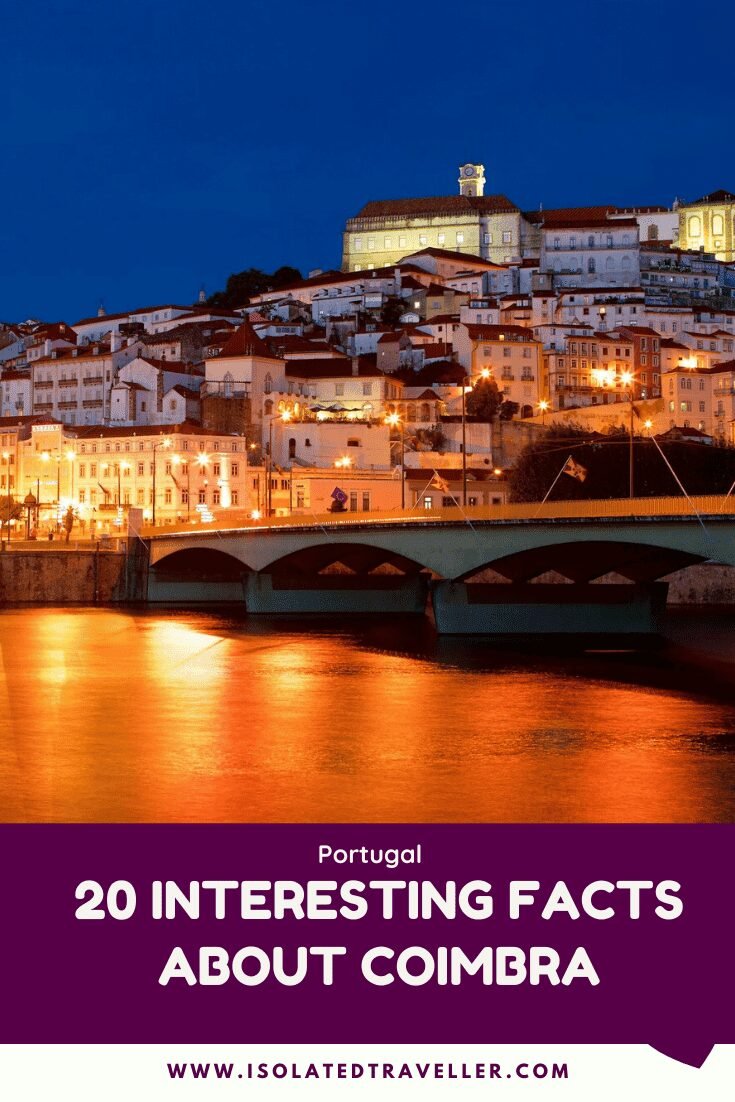Coimbra Summary
Coimbra, a riverfront city in central Portugal and the country’s former capital, Among the many archaeological structures dating back to the Roman era, when Coimbra was the settlement of Aeminium, are its well-preserved aqueduct and cryptoporticus. Its steeply stacked historic center dates to Moorish times.
Facts About Coimbra:
Coimbra was the capital city of the nascent kingdom between 1139 to 1256 until it was eclipsed by Lisbon.
University of Coimbra General Library, Portugal’s second biggest library, after the National Library in Lisbon
The University of Coimbra, the oldest academic institution in the Portuguese language-speaking world, situated in Coimbra.
Coimbra is famous for Coimbra fado, a fado genre that originated in the city. It is played exclusively by male performers dressed in traditional student uniforms.
Administratively, the municipality is divided into 18 civil parishes: Almalaguês; Antuzede e Vil de Matos; Assafarge e Antanhol; Brasfemes; Ceira; Cernache; Coimbra (Sé Nova, Santa Cruz, Almedina e São Bartolomeu); Eiras e São Paulo de Frades; São João do Campo; São Martinho da Árvore e Lamarosa; São Martinho do Bispo e Ribeira de Frades; São Silvestre; Souselas e Botão; Santa Clara e Castelo Viegas; Santo António dos Olivais & Taveiro, Ameal e Arzila.
Carlos Seixas one of Portugal’s notable sons: born and raised in Coimbra.
Coimbra celebrates its municipal holiday on 4 July, in honor of Queen Elizabeth of Portugal, a religious and civic celebration that celebrated the life of the former Queen, which includes a fireworks display.
Coimbra is twinned with: Aix-en-Provence, France; Beira, Mozambique; Cambridge, US; Curitiba, Brazil; Daman, India; Dili, East Timor; Esch-sur-Alzette, Luxembourg; Fes, Morocco; Halle, Germany; Ilhas, Macau; Mindelo, Cape Verde; Padua, Italy; Poitiers, France; Quelimane, Mozambique; Salamanca, Spain; Santa Clara, US; Santiago de Compostela, Spain; Santos, Brazil; São Paulo, Brazil; Yaroslavl, Russia; Zaragoza, Spain; Santarém, Portugal; Lahore, Pakistan.
The Diário de Coimbra and the Diário As Beiras are the two major newspapers based in Coimbra.
Coimbra has been called A Cidade dos Estudantes (The city of the students) or Lusa-Atenas (Lusitan-Athens), mainly because it is the site of the oldest and one of the largest universities in Portugal.
Coimbra is also the place where the oldest and biggest university students’ union of Portugal was founded – the Associação Académica de Coimbra (Academic Association of Coimbra), established in 1887.
The two banks of Mondego River at Coimbra, are linked by three main bridges: the Ponte do Açude, the Ponte de Santa Clara (which is the oldest) and Ponte Rainha Santa, also known as Ponte Europa.
The Population of Coimbra is around 143, 396, as of 2019.
The city, located on a hill by the Mondego River, was called Aeminium in Roman times. It fell under the influence, administratively, of the larger Roman villa of Conímbriga.
Coimbra has a warm-summer Mediterranean climate, In winter, temperatures range between 15 °C, while summer temperatures range between 29 °C.
The city is on the Portuguese Way of the Road of St James.
Machado de Castro Museum, the second most important one in Portugal, housed in the former Episcopal Palace.
University of Coimbra historical buildings was classified as a World Heritage site by UNESCO in 2013.
Portugal’s first king, Afonso Henriques, is buried in the Santa Cruz Monastery, in Coimbra.
One of Europe’s tallest trees, Karri Knight can be found in Valle de Canas of the municipality of Coimbra. It is a Eucalyptus diversicolor of 73 m height and of 5.71 m girths.



1 Comment
Comments are closed.